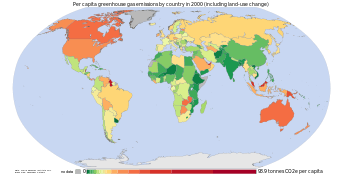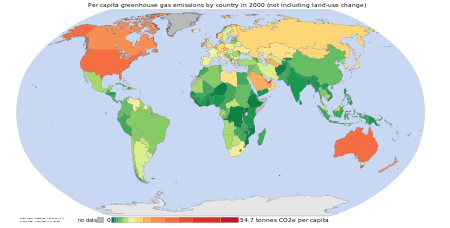Land use, land-use change and forestry
Land use, land-use change and forestry (LULUCF) is defined by the United Nations Climate Change Secretariat as a "greenhouse gas inventory sector that covers emissions and removals of greenhouse gases resulting from direct human-induced land use, land-use change and forestry activities."[1]
LULUCF has impacts on the global carbon cycle and as such, these activities can add or remove carbon dioxide (or, more generally, carbon) from the atmosphere, influencing climate. LULUCF has been the subject of two major reports by the Intergovernmental Panel on Climate Change (IPCC). Additionally, land use is of critical importance for biodiversity.
Climatic impacts of land-use, land-use change and forestry

Land-use change can be a factor in CO2 (carbon dioxide) atmospheric concentration, and is thus a contributor to global climate change. IPCC estimates that land-use change (e.g. conversion of forest into agricultural land) contributes a net 1.6 ± 0.8 Gt carbon per year to the atmosphere. For comparison, the major source of CO2, namely emissions from fossil fuel combustion and cement production amount to 6.3 ± 0.6 Gt carbon per year.[2]
This decision sets out the rules that govern how Kyoto Parties with emission reduction commitments (so-called Annex 1 Parties) account for changes in carbon stocks in land use, land-use change and forestry. It is mandatory for Annex 1 Parties to account for changes in carbons stocks resulting from deforestation, reforestation and afforestation (B Article 3.3)[3] and voluntary to account for emissions from forest management, cropland management, grazing land management and revegetation (B. Article 3.4).
The rules governing the treatment of land use, land-use change and forestry for the second commitment period are part of the Bali Action Plan under the Ad Hoc Working Group on Further Commitments for Annex 1 Parties under the Kyoto Protocol (AWG-KP).[4]
The most recent options for rule changes under consideration are summarized in a "Non-Paper" the co-chairs of the contact group on LULUCF (as of June 12).[5]
The impact of land-use change on the climate is also more and more recognized by the climate modelling community. On regional or local scales, the impact of LUC can be assess by Regional Climate Models (RCMs). This is however difficult, particularly for variables, which are inherently noisy, such as precipitation. For this reason, it is suggested to conduct RCM ensemble simulations.[6]
Land use and biodiversity

The extent, and type of land use directly affects wildlife habitat and thereby impacts local and global biodiversity. Human alteration of landscapes from natural vegetation (e.g. wilderness) to any other use typically results in habitat loss, degradation, and fragmentation, all of which can have devastating effects on biodiversity. Land conversion is the single greatest cause of extinction of terrestrial species.[7] An example of land conversion being a chief cause of the critically endangered status of a carnivore is the reduction in habitat for the African wild dog, Lycaon pictus.[8]
Deforestation is also the reason for loss of a natural habitat, with large numbers of trees being cut down for residential and commercial use. Urban growth has become a problem for forests and agriculture,the expansion of structures prevents natural resources from producing in their environment. The loss of forest land is estimated to have been sixteen to thirty four million. In order to prevent the loss of wildlife the forests must maintain a stable climate and the land must remain unaffected by development. The U.S. Forest service predicts that urban and developing terrain in the U.S. will expand by forty one percent in the year 2060. These conditions cause displacement for the wildlife and limited resources for the environment to maintain a sustainble balance.[9]
See also
References
- ↑ Land use, land-use change, and forestry (LULUCF), Glossary of climate change acronyms, UNFCCC website. Retrieved 2009-01-11.
- ↑ "Vital Climate Graphics | UNEP/GRID-Arendal - Publications - Vital Climate Graphics". Grida.no. Retrieved 2010-04-29.
- ↑ "Microsoft Word - kpcmp8a3.doc" (PDF). Retrieved 2010-04-29.
- ↑ AWG-KP begins final year of work, UNFCCC website. Retrieved 2009-10-11.
- ↑ A text on other issues outlined in document FCCC/KP/AWG/2008/8, UNFCCC website. Retrieved 2009-10-11.
- ↑ Laux et al., 2016 , Laux, P., Nguyen, P. N. B., Cullmann, J., Van, T. P. and Kunstmann, H. (2016), How many RCM ensemble members provide confidence in the impact of land-use land cover change?. Int. J. Climatol.. doi:10.1002/joc.4836
- ↑ Bierregaard, Richard; Claude Gascon; Thomas E. Lovejoy; Rita Mesquita, eds. (2001). Lessons from Amazonia: The Ecology and Conservation of a Fragmented Forest. ISBN 0-300-08483-8.
- ↑ C. Michael Hogan. 2009. Painted Hunting Dog: Lycaon pictus, GlobalTwitcher.com, ed. N. Stromberg Archived 2010-12-09 at the Wayback Machine.
- ↑ National Conference of State Legislature."State Forest Carbon Incentives and Policies".Jocelyn Durkay and Jennifer Schultz..22 March, 2016. Web.25 April 2015.http://www.ncsl.org/research/environment-and-natural-resources/state-forest-carbon-incentives-and-policies.aspx
External links
- Good Practice Guidance for Land Use, Land-Use Change and Forestry
- IPCC Special Report on Land Use, Land-Use Change, and Forestry
